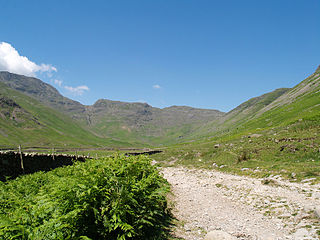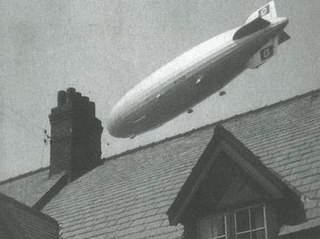The Keswick to Barrow Walk, also known as the K2B, is a 40 mile charity walking and running event which takes place annually in May in Cumbria, England, between Keswick and Barrow-in-Furness. The walk passes through much of the Lake District. It allows participants to run or walk as they choose. Most choose to walk, while the running contingent compete for the fastest runner trophy.
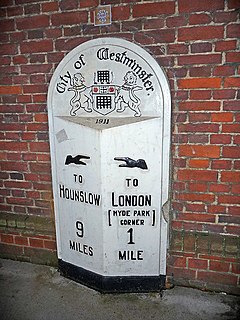
The mile is an English unit of length of linear measure equal to 5,280 feet, or 1,760 yards, and standardised as exactly 1,609.344 metres by international agreement in 1959.
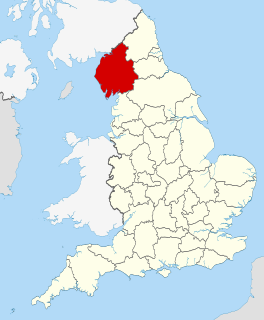
Cumbria is a ceremonial and non-metropolitan county in North West England. The county and Cumbria County Council, its local government, came into existence in 1974 after the passage of the Local Government Act 1972. Cumbria's county town is Carlisle, in the north of the county, and the only other major urban area is Barrow-in-Furness on the southwestern tip of the county.

Keswick is an English market town and a civil parish, historically in Cumberland, and since 1974 in the Borough of Allerdale in Cumbria. Lying within the Lake District National Park, Keswick is just north of Derwentwater and is 4 miles (6.4 km) from Bassenthwaite Lake. It had a population of 4,821 at the 2011 census.
The walk has it origins in a 1966 challenge between a team of American experts working on the construction of HMS Resolution in Barrow, and local workers from Vickers, the owners of Barrow's shipyard. [1] The challenge was inspired by American President John F. Kennedy's recommendation that "every American should be capable of walking 50 miles a day" [1] The original walk started at the Castlerigg Stone Circle, roughly 50 miles from Barrow, but the length of the walk was in following years reduced to around 40 miles, starting south of Keswick. [1] The walk proved popular and became an annual event. By 1974 it had 1,500 participants, [1] and has continued to grow. Entry is currently capped at 2,900 walkers for logistical reasons, [2] and the event is regularly oversubscribed.
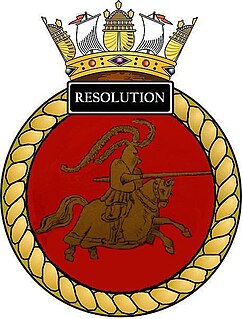
HMS Resolution (S22) was the first of the Royal Navy's Resolution-class ballistic missile submarines.
Vickers was a famous name in British engineering that existed through many companies from 1828 until 1999.

John Fitzgerald Kennedy, often referred to by initials JFK and Jack, was an American politician who served as the 35th president of the United States from January 1961 until his assassination in November 1963. Kennedy served at the height of the Cold War, and the majority of his work as president dealt with managing relations with the Soviet Union and Cuba. A Democrat, Kennedy represented Massachusetts in the U.S. House of Representatives and Senate prior to becoming president.
For many years, the route began at Rough How Bridge on the A591 three miles south of Keswick. [3] However, for the walk's fiftieth anniversary in 2016 and again in 2017, the start was moved to near Castlerigg Stone Circle, increasing the distance to around 43 miles. The walk follows minor roads along the west of Thirlmere, before climbing up Dunmail Raise. It passes through the village of Grasmere and over Red Bank into Elterwater and on to Coniston. Walkers then continue along the east bank of Coniston Water to the village of Lowick, before passing over Kirkby Moor, the walk's highest elevation. The route then continues into Low Furness and the village of Marton, passing the South Lakes Wild Animal Park on its way to Dalton-in-Furness. The final stretch runs close to Furness Abbey, before ending at the Hawcoat Park Sports Club in Hawcoat, Barrow. [4] The shorter Coniston to Barrow walk is aimed at teenagers, and joins the main route in Coniston. [5]

The A591 is a major road in Cumbria, in the north-west of England, which lies almost entirely within the Lake District national park. A 2009 poll by satellite navigation firm Garmin named the stretch of the road between Windermere and Keswick as the most popular road in Britain. The 29.8 mile stretch between Kendal and Keswick was also named the UK's best driving road, according to a specially devised driving ratio formulated by car rental firm Avis.

Thirlmere is a reservoir in the Borough of Allerdale in Cumbria and the English Lake District. The Helvellyn ridge lies to the east of Thirlmere. To the west of Thirlmere are a number of fells; for instance, Armboth Fell and Raven Crag both of which give views of the lake and of Helvellyn beyond. It runs roughly south to north and is bordered on the eastern side for much of its length by the A591 road and on the western side by a minor road. It occupies the site of a former natural lake: this had a fordable waist so narrow that it was sometimes regarded as two lakes. In the 19th century Manchester Corporation constructed a dam at the northern end, raising the water level, flooding the valley bottom, and creating a reservoir to provide the growing industrial city of Manchester with water supplies via the 96 mile-long Thirlmere Aqueduct. The reservoir and the aqueduct still provide water to the Manchester area, but under the Water Act 1973 ownership passed to the North West Water Authority; as a result of subsequent privatisation and amalgamation they are now owned and managed by United Utilities, a private water and waste water company.
Dunmail Raise is the name of a large cairn in the English Lake District, which may have been an old boundary marker. It has given its name to the mountain pass of Dunmail Raise, on which it stands. This mountain pass forms part of the only low-level route through the mountains between the northern and southern sides of the Lake District. According to local tradition, the cairn marked the burial of a king named Dunmail who was slain by Saxons. The place name itself may well be derived from the name of the historical Dyfnwal ab Owain, King of Strathclyde.
Competitors enter in teams of between 6 and 12, [6] and prizes are awarded to both individuals and teams. [7] The competition retains a close association with BAE Systems, current owners of Barrow's shipyard, and teams from the armed forces, with prizes for the best performers among both groups [7] Competitors must raise a minimum of £80 for charity for their entry to be accepted. [8] Up to 2016, more than £3.7M has been donated to charities over the history of the walk.
BAE Systems plc is a British multinational defence, security, and aerospace company. Its headquarters are in London in the United Kingdom with operations worldwide. The company is the largest defence contractor in Europe and among the world's largest defence companies; it was ranked as the third-largest based on applicable 2017 revenues. Its largest operations are in the United Kingdom and United States, where its BAE Systems Inc. subsidiary is one of the six largest suppliers to the US Department of Defense. Other major markets include Australia, India, and Saudi Arabia, which account for about 20% of BAE's overall sales. It is the biggest manufacturer in Britain. The company was formed on 30 November 1999 by the £7.7 billion merger of two British companies: Marconi Electronic Systems (MES) – the defence electronics and naval shipbuilding subsidiary of the General Electric Company plc (GEC) – and British Aerospace (BAe) – an aircraft, munitions and naval systems manufacturer.


